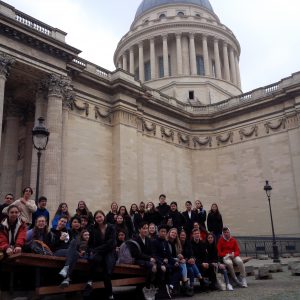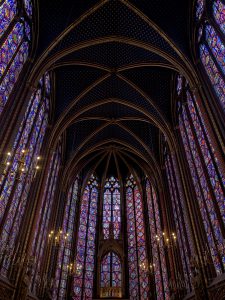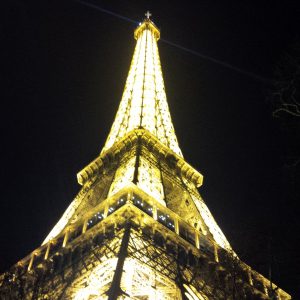Ce matin, nous devions nous lever un peu plus tôt pour nous assurer que nous pouvions visiter le Panthéon, où plusieurs personnes importantes sont enterrées. Nous avons vu les tombes de Pierre et Marie Curie, Emile Zola, Victor Hugo et d’autres anciens grands citoyens français. Après ça, nous sommes allés à la Conciergerie, un bâtiment qui était un palais à l’origine, mais qui a été converti en prison. C’était là où Marie Antoinette a passé ses derniers moments. Juste à côté est la Sainte-Chapelle, qui est pleine de vitraux qui atteignent le plafond. Puis, après un rapide déjeuner juste dehors de la Sainte-Chapelle, nous avons visité l’Opéra Garnier, qui a de belles dorures partout. Soi-disant, c’est où le célèbre Fantôme de l’Opéra demeure présentement. Après l’Opéra, nous avons pris le métro pour dîner dans un restaurant. C’était notre dernier repas tous ensemble. Nous étions assis dans une ancienne cave du 13e siècle et quelques étudiants ont mangé des escargots! Nous étions censés à monter au somment de l’Arc de Triomphe, mais il n’y avait pas assez de temps alors nous sommes seulement allés sur la rue face à l’Arc de Triomphe, les fameux Champs-Elysées, pour faire un peu de shopping. Nous nous sommes divisés en groupes (un pour les vêtements, un pour les souvenirs, etc) pour que tout le monde puisse acheter ce qu’ils voulaient. Après ça, on a brièvement vu l’Arc de Triomphe et puis nous sommes allés à la Tour Eiffel. Les mesures de sécurité étaient très importantes et longues, mais la vue en haut était magnifique. Paris par de nuit, est magnifique !
Par: Kira






Today was a long day: travelling the streets of Paris to the last few monuments we hadn’t seen yet. Our first stop was the Pantheon, a tomb for notable French citizens like Pierre and Marie Curie, Voltaire and Alexandre Dumas. Inside the domed building are frescos and paintings, patterned floors, a gift shop and the crypt. We took the Metro to visit the Conciergerie de la Cité, once a palace, then a prison and now a museum. Its exhibitions are mainly of the French Revolution when it held many people before executions such as Marie Antoinette. Just next door was the Saint-Chapelle, a beautiful 12th century chapel that is not in the austere gothic style that so many cathedrals are. It has the same vaulted arches and stained-glass windows, but the walls and columns are full of colour with intricate fleur-de-lys and castle patterns. The ceiling was navy with stars painted on. We stopped for lunch outside the Opera, or Palais de Garnier, which would be our next monument. With a guided tour, we learned the symbolism carved into all 30 different types of marble. The Opera is an opulent, mysterious construction planned almost singlehandedly by Charles Garnier. Originally reserved for the rich, its halls are more resplendent than Versailles. We went to dinner in the converted 13th century wine cave of a Paris restaurant before heading to Champs-Elysées to shop. As it was fairly late by this time, we had 35 minutes before rushing to the Eiffel Tower. It was well-lit in the night, and every now and then glittered with flashing lights. We rode the elevators to the very summit. There was a view of Paris in the night: the Seine, the square below the tower, Notre-Dame etc. It was an amazing experience, and a couple hours later some of us slept on the train back.
Par: Pascale
Par/by Pascale et Kira
